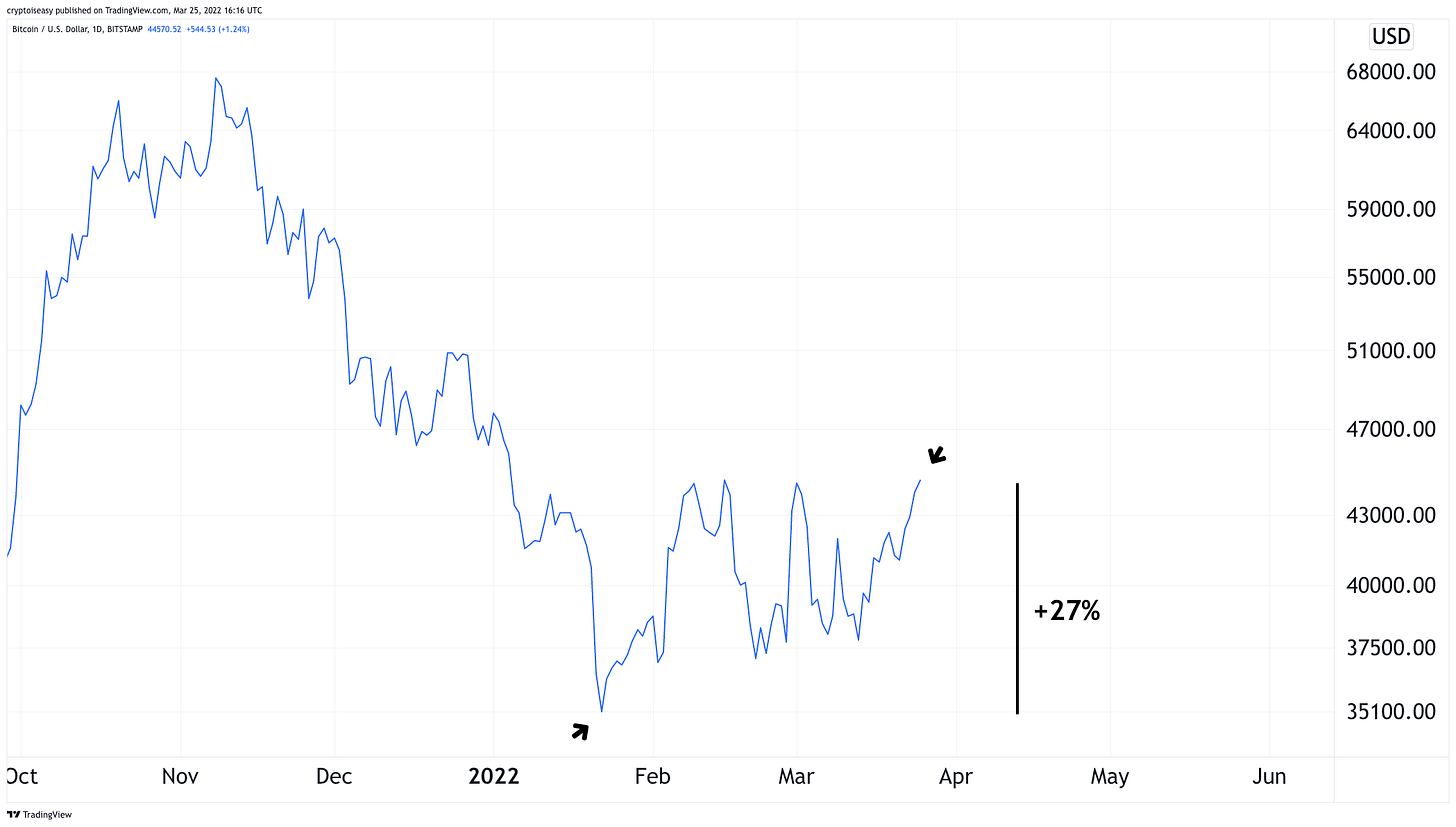If the embedded audio narration isn’t working properly or doesn’t sound good, tap this button to switch over to the podcast version.
In last month’s issue, I shared my thoughts about data models, analysis, and the expectations that they create.
This month, I talk about government and sentiment.
Did you heard about Goblin Town? Apparently, the crypto market’s in it.
What’s Goblin Town?
“A dark, depressing place where dreams die and anguish reigns.”


Where I come from, we call that a “day job.”
I get it. Since the market reached its zenith in November, overall trading volume has dropped every month, along with prices.
Actually, prices have gone up for two months.
Also, on a monthly basis, volume peaked in December 2020, not November 2021. It’s gone down for 15 months, even though bitcoin made multiple new all-time highs over that time.
See for yourself:
Mark, that can’t be. 2021 was crazy! Laser eyes, supercycle, etc.
Yea. Kinda like when you get to a party at 2 am. Everybody’s happy but you already missed most of the fun. You only get the tail end and the hangover that comes the next day.
Be careful with conclusions
To be fair, volume is not a meaningful statistic and it will continue to mean less as more money flows to derivatives and investment funds instead of the spot market.
Those products let people speculate on crypto prices without actually buying or selling crypto. The spot market still sets prices, but a lot of the volume flows elsewhere. Maybe not the best metric to look at.
Can you ever really find clarity in a single metric? Good analysis demands a lot more nuance than any creator can squeeze into a tweet, Reddit post, or YouTube video. When you use only one single source or agree with only the most common viewpoint, your first conclusions are sometimes wrong.
For example, entity data, a type of analysis that came into vogue last year. This data uses inference and heuristics to figure out how transactions are linked to one another. From that, analysts can identify unique entities and the bitcoins they control.
Its best producer, Glassnode, warns people that the data includes a lot of guesswork.
On top of that, entity data obscures what the actual bitcoins are doing, which is for me the most important information you get from on-chain data. An entity can buy, sell, and move 10 bitcoins and leave no trace in the entity data. To find those bitcoins, you need to look at other metrics.
At the end of the day, I don’t need to know what the entities are doing, I need to know what the bitcoins are doing.
Some prefer whale watching. A few of the biggest wallets have an uncanny ability to sell near the local tops and buy near the local bottoms. Often, they’re off by weeks, during which time the price can move 25-50%.
Many people apply some form of technical analysis. Traders use that type of analysis to plan entries, exits, stop-losses, and hedges. Essentially, it’s a risk-management tool for people who want to make money from changes in the prices of cryptos.
Is that your goal? If not, are you sure you want to make decisions based on technical analysis?
What about fractals? Can you take one outcome from one event on one dimension at one point in time, then use it to form your expectations of this moment?
At best, you can stack a few fractals over each other across several dimensions with perfect alignment. Like, 5 or 6 independent points of data, not two coincidences across different timeframes. Unfortunately, you’re not going to find those very often.
Lots of people think bear markets are bad. For an investor, bear markets are a godsend. You get to buy everything at a discount, pay lower fees, suffer no FOMO, and your mistakes hurt you a lot less than they do during the bull markets.
Bull markets feed you for a day. Bear markets feed you for a lifetime.
Choose your conclusions wisely.
Fear not ye for government
For a while, I have heard people talk about how governments will kill crypto.
Doubtful.
Trim its excesses? Cut down on the scams? Funnel its benefits to a privileged few? Crush innovation in one or a few countries?
Seems a lot more likely to me.
In any event, it won’t matter for crypto’s success. This is a global asset with no borders and no way to stop people from using it (yet). Money, talent, and effort will go wherever it can do the most good.
China kicks out miners, US brings them in. The UK shuts down bitcoin ATMs, South Korea loosens up on crypto exchanges. Russia and Ukraine are both trying to use crypto for their own benefits.
Now the US wants to build a regulatory framework for crypto. The White House gave US agencies until the end of this year to report activities and recommendations. Input will come from all corners of the bureaucracy—technology, environmental protection, national security, law enforcement, tax administration, and finance.
Once the administration settles on its regulatory plans, it will take months to collect public comments, negotiate administrative differences among agencies, resolve conflicting areas of authority, and implement changes.
While the bureaucrats work out the details, you never know what Congress might do. There’s a reason the US government is always two steps behind the private sector.
And seeing the US dollar as a central bank digital currency? Maybe one day. Not any time soon. Watch my brief video about how the US bureaucracy works. It may seem like satire, but it’s not.
Learn to love lobbyists
Today, we have lobbyists, special interests, Wall Street, and people with deep pockets willing to speak up for us.
In 2021, crypto companies spent $9 million on lobbyists, presumably more from private citizens. Even the U.S. Chamber of Commerce sent crypto lobbyists to Congress.
While that’s not a lot of money, it ain’t nothing.
More importantly, its working. Lobbyists are finding partners and allies who can advocate on our behalf, like oil companies, rich people, and payment processors.


Last summer, US Congress debated an infrastructure bill that could have crushed crypto developers. After outrage from the crypto community, a coalition of members changed the language and US regulators promised not to crush crypto developers.
Who generated that outrage?
Lobbyists.
It takes a lot of money and savvy to get people mad enough to take action.
Such efforts not only change laws but also change minds. More with every passing day.
We need lobbyists to show rulemakers that we’re not a bunch of scammers, money launderers, and anarcho-capitalists trying to rip people off, evade taxes, and destroy the global financial system. Those people represent only a small segment of the industry—a segment that gets smaller with every passing day.
Better yet, lobbyists can show members how they and their constituents benefit from crypto.
For some members, that means votes, money, and publicity.
For others, that means a legacy, or maybe a job if they get voted out of office, or perhaps a genuine desire to use technology for the public good.
Whatever the motivation, a lobbyist will find it. As a result, we benefit.
Enough politics, Mark. Shut up and play football
Right, I understand. You don’t want to hear my thoughts about government. What’s bitcoin’s price going to do, up or down? Make me rich, Mark!
Sure, no problem.
Follow my plan and don’t sweat the details.
You may not do as well as a good trader, but you’ll beat the bad ones and you’ll come out ahead of anybody who dollar-cost averages.
Today, you’re down 14% at the most on your bitcoin, probably close to even or ahead on your investment, and possibly up 700% or more.
(With altcoins, you may do much better or much worse.)
Whenever bitcoin’s price is outside of my plan’s buying zone, convert your cash into stablecoins and deposit them on a savings platform for 7-12% interest. Use my crypto savings referral links for a little boost on your deposit.
Tomorrow’s assets will look nothing like today’s
Do you ever wonder why I call cryptocurrencies the financial networks of the future?
It’s not because they will replace money or government currencies.
Rather, it’s because the legacy financial system can’t compete with global, free, immutable computer protocols that function everywhere, all the time, for everybody, without human intervention.
That legacy system can’t scale fast enough, operate cheaply enough, or cut enough manpower to compete with developers, engineers, and marketers working on laptops and patched into distributed social networks. With cryptocurrency as the incentive, builders can harness the world’s collective creativity and energy towards solving huge technological problems and crafting all sorts of financial structures and applications.
Do you think a few old people in suits—or even a group of young people in sweatpants—can outcompete that?
Imagine hand-written scrolls beating the printing press, mail carriers beating the telegram, telegrams beating the telephone, or telephones beating the internet.
Over time, NFTs will replace deeds, titles, membership cards, royalty agreements, leases, and many types of collectibles. Governance tokens will replace common stock. DeFi protocols will replace bonds and fixed-income products. Altcoins will replace alternative and liquid assets, each serving a unique function within the larger world economy.
Bitcoin will serve as the settlement layer for most commerce, with apps, bridges, side-chains, and second-layer protocols to handle routine transactions.
All the world’s wealth will be scalable, transferrable, and infinitely divisible.
Once the laws catch up
Eventually.
Before this thing can reach the mainstream, we need laws that make sense. Our modern financial system rests on tenets and principles from the industrial age. You can’t build a 21st Century financial system on 20th Century laws.
Too many people have too many questions about taxes, accounting, regulations, registrations, consumer and privacy rights, and what they can get sued or fined for. FYI this is the biggest reason I don’t leverage NFTs for my business (yet). The legalities remain vague.
Until that changes, let’s temper our expectations of how quickly this technology will go mainstream.
When the market goes back to all-time highs, people will tell you it’s mainstream. For me, it’s not mainstream until I can find an accountant who can handle the crypto portion of my taxes.
The good news for us?
We don’t need crypto to go mainstream. We just need it to grow.
By the time this technology hits the mainstream, the market will be so big, mature, and sophisticated, we will no longer have this amazing investment opportunity. VCs, insiders, and financial experts will beat us to it—if they haven’t already done so.
The traditional investment paradigm is dead
This is inevitable, especially when you consider how the legacy financial system no longer gives you any expectation of yield.
I’m aware you may have a different investment environment where you live. I’ll use the US markets for my examples in this newsletter.
With US blue-chip stocks, the kinds typically found in the S&P 500, you can get an average 1.3% dividend on top of any future growth. Sounds great, right? These are the best businesses in the world!
At the same time, that average dividend is near the lowest in history. Relative to all historical benchmarks, the S&P 500 is massively overbought. The Shiller P/E chart, which accounts for inflation, sits at the second-highest reading ever recorded—behind only lead-up to the peak of the dot-com bubble burst.
What about small caps?
Using the iShares Russell 2000 ETF as our benchmark, we can see an average dividend of 1% for small corporations. Less than the blue chips.
You may think that’s ok, after all, these small businesses have more room to grow.
The problem?
Roughly 40% of those businesses had no profits in 2021. Let’s hope more of them can show profits this year.
And bonds?
US junk bonds give you about 6% annual interest. That’s less than the rate of inflation and this debt comes from businesses that either have no money or want to use your money to speculate on high-risk investments. Also, you lose your investment if the company fails.
Is 6% enough to compensate you for probably never getting your principal back?
Government bonds offer more security but they pay you barely more than a savings account (almost nothing). Your capital can never grow and when you account for inflation, you’re basically locking yourself into a contract that will lose money.
At least with stocks, you *might* see your investment go up.
Little wonder why investors have started flocking to art and commodities. Risky investments don’t reward you for your efforts and safe investments are guaranteed money losers. At least you can use pictures and metals!
For many of us, our parents grew up in a world where the financial system could provide safe yields and low-risk ways to protect our wealth. That world no longer exists.
Maybe it’s time to try a new one?
Obviously not, Mark. Price are not going up!
Are you sure? The total crypto market’s up 27% over the past 62 days.
Tame by crypto standards, I know. If it makes you feel better, in two weeks the market will have gone up for longer from January to now than it went down from November to January.
Either way, don’t worry about it. Price is simply a function of buyers and sellers. It tells you nothing about the investment opportunity.
Neither do war, peace, government, stocks, or seasons. You won’t find opportunity in green dildos, “mainstream” coverage, the crypto-related search volume on Google trends, the number of active addresses, or any measure of hype, fear, or greed.
This market rises in two steps:
Crypto flows to people who want it more than they want their government’s money.
Prices go up long enough for people to think prices will keep going up. Then, they buy. Everything else takes care of itself.
Those steps never change.
Once step 1 is complete, you’re already behind the curve. If you wait for step 2 to finish, you will miss out on the best opportunities.
You may wonder where the new money will come from or what will “spark” the next leg up. What’s the next narrative? Where’s the big catalyst?
Narratives and catalysts come after the price goes up. That’s when people need reasons to justify chasing the market higher.
Freedom money? Inflation hedge? Fast money before the next crash? “These guys know what they’re doing” so they’ll make me rich? A great trading opportunity? An asset for my children? Prices will never go lower?
Only matters when the price goes up.
That is the beauty of bitcoin and every altcoin that builds a strong community or a robust use case. You get to decide what makes it a good investment.
I do this, too. I published my reasoning for bitcoin in my bitcoin investment thesis.
For altcoins, I pick each for its own reason. Since I have about 50 of them, it’s too much to put here. Occasionally, I publish one of them as an altcoin report.
Unsafe at any price
Does that mean you need to wait for the price to go up before you put money into the market?
In a recent survey of my subscribers, 15% of respondents said they’re doing just that.
Most people take the same approach. In 2021, bitcoin maximalists told you that’s what institutional investors do, too. The higher the price goes, the safer it is. You have to wait until the price goes up, otherwise, you’re stupid. Never catch a falling knife!
Truth be told, it does feel safer when the price goes up. Search volume and exchange activity go up. Active addresses and many other metrics rise. You see and hear more people talk about it. That validates your decision.
The problem is, this all happens after the best opportunities have passed. Once search volume spikes, exchanges get more traffic, popular people get active again, and you hear “nobody’s selling,” you need to push that feeling of safety out of your head.
This market is never safe.
The bottom is always $0, no matter how high bitcoin and altcoin prices go.
If you follow my plan, you will not have to worry about this unless you want to.
Mark, always with the plan, why do you always hype the plan?
It’s not hype, it’s conviction.
When you can condense all buying decisions into three lines on a chart and set very clear selling signals, this market gets very easy.
Imagine you figured out how to do that. Wouldn’t you want to tell people about it?
At all times, this market is variable, volatile, with a huge margin for error and a wide range of outcomes. My plan puts those attributes in our favor.
When you have a high-ceiling asset class with limitless potential in the middle of a 13-year uptrend and massive tailwinds, you just need to take advantage of opportunities when they present themselves. Let the market take care of everything else.
Save your money and energy for those moments. Sell only when the market forces you to do so.
Some of the decisions seem counterintuitive but you’ll do better than most, worse than some, and never worry until there’s a reason to worry.
Along with my plan, I also post one or two updates each week for premium subscribers. In those updates, I look at data on the behaviors of people in the market and other metrics, sometimes mixed in with reflections on my own experiences, to get a sense of perspective around what’s going on at any given time and set some realistic expectations.
If you’re not already on the paid plan, you may want to upgrade your subscription before the next big move happens.
Big move, shmig move
I hear ya.
That kind of thinking takes me back to the beginning of 2019, which most people consider a bear market. Bitcoin’s price only doubled that year. Big letdown.
I sold half of my crypto in March 2019. Some data models and traders said we should expect bitcoin’s price to drop from $4,000 to $3,000, and I figured I’d buy it back later at a big discount.
It didn’t work out the way I expected.
Fortunately, altcoins didn’t budge much when bitcoin zoomed. I had a heavy allocation to altcoins, and still do, so I was able to basically buy my tokens back in early April at roughly the same price I sold at. I lost maybe 10% overall, plus fees.
That 10% is a lot of money now, but what can you do? A lot of people didn’t buy until the price went above $10,000, just before the market crashed in July after bitcoin briefly tapped $14,000.
You’d be surprised how many people refused to buy below $4,000 because it was too risky, but happily bought at $10,000 thinking it was a sure thing.
True, but irrelevant
Many people think this most recent bull market started in March 2020 and ended in April 2021.
From the data I look at, the market bottomed in December 2018 was already showing signs of weakness by November 2020.
In November 2020, large HODLers started taking profits. Key on-chain metrics had already turned against us. Greed started creeping back into the market. OGs started peeling out.
At the time, I said the market wasn’t ready to boom.
While that was true, it didn’t matter. Speculative enthusiasm overwhelmed the market. The crypto market turned into a crypto casino. I didn’t buy another penny of bitcoin until May 2021.
You probably entered around late 2020 or early 2021. Remember laser eyes? “Institutions won’t let the market crash.” $100,000 guaranteed. $288,000 by the end of the year. Supercycle. “Nobody’s selling.”
You may think that kind of blind hype can’t happen again. People are too smart. The market’s too big, it would take too much money. Governments will try to stop it. Insert your own reason to doubt.
And yet, today’s market is about the same size as it was in January 2021. It’s 30% higher than it was in June 2021. Both times, the market doubled in the months that followed.
What has changed so much now that we can’t get those same outcomes?
Trading charts show bullish divergences and trend shifts across many indicators on many timeframes. On-chain data shows a lot of selling pressure has left the market.
Good sailors don’t fear choppy waters
So, “only up” from here?
We shall see. Why can’t we get one more drop before Moontown? It’s happened before in similar circumstances.
Any price between $20,500 and $150,000 fits into the “normal” range of bitcoin’s volatility. Altcoins can go up or down 50% at any moment.
In November and December, we saw institutions and summer tourists leave while OGs took profits.
In December and January, we shed some whales and leveraged traders.
In February and March, we saw miners sell a little more than usual as trading volumes disappeared, institutions started trickling back in, diamond hands gobbled up a big chunk of supply, and buy orders stacked up below $33,000.
Now we see accumulation and constructive growth across all dimensions. Key bitcoin metrics like the stablecoin supply ratio oscillator, aSOPR, and rHODL show levels that only appear when the market’s in a healthy spot. Various measures of altcoins show they’re generally keeping pace with bitcoin (some better than others), both in terms of price and usage.
So, what can you do about it?
Whatever you want. Premium subscribers, you know what I’m doing—just following my plan.
Today, you may not need my plan. If you want to build wealth with crypto, you have only one good decision at this moment, and it’s an easy one.
If you want to make money buying and selling crypto, that’s a different story. You may never need my plan. Hopefully, my newsletter gives you some perspective to make better decisions, appreciate the market conditions, and discover some information you won’t find in trading charts.
Once the market seems safe, that’s when you’ll need my plan the most.
At that point, all the decisions will get harder. Prices will keep going up after the opportunity has passed. Drops will go lower than you could ever imagine. Every bullish fractal will seem utterly convincing. Every bearish observation will seem utterly foolish. Each dip will seem like a buying opportunity, but only some will be.
Steady as she goes
What happens next? Will we get the +100% gains we’ve seen in previous bear markets? Or the +30% drops we’ve seen in previous bull markets? Experts on both sides have called for each of these outcomes.
Does the world go into a global recession from shortages of oil and grain? Will the US and Chinese economies continue to slow down? Will war in Ukraine spill over to Europe and Asia? What other calamity lurks just around the corner, hidden today by the vagaries of the markets and the fog of financial speculation?
We shall see.
This market always goes wherever bitcoin goes.
Fortunately, with bitcoin, we can see the behaviors of people in the market. We can see it in the movements of bitcoins, the flows in and out of various funds and exchanges, and all sorts of measures of human behavior.
Anything that happens in the larger world will appear in this data. Bitcoin’s blockchain captures all transactions.
Everything else? Just details. Worry about these things because they matter for humanity, our individual fates, and the fates of people we care about.
As far as crypto goes, act when the situation demands it and you’ll be ok.
Relax and enjoy the ride!













